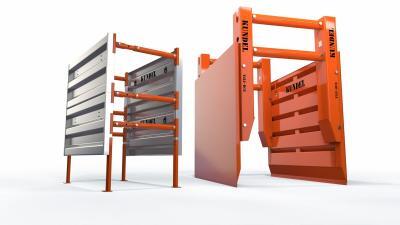What is a Cable Duct?
A cable duct, also known as a cable conduit or cable channel, is an underground structure designed to house and protect electrical or communication cables. It provides a dedicated pathway for cables, facilitating their installation, organization, and maintenance. Cable ducts are commonly used in urban areas, industrial complexes, and other locations where cables need to be routed underground.
Key Features and Benefits of Cable Ducts:
- Protection: Cable ducts provide a protective barrier for cables, shielding them from environmental factors such as moisture, dirt, chemicals, and physical damage. This helps to ensure the longevity and reliability of the cables.
- Organization: By providing a dedicated pathway, cable ducts help in organizing and managing cables efficiently. They prevent cables from becoming tangled or entwined, making it easier to identify and access specific cables when needed.
- Installation: Cable ducts simplify the process of cable installation. Cables can be easily laid within the ducts, reducing the time and effort required for underground cable installation. This also minimizes the chances of cable damage during the installation process.
- Maintenance: In case of repairs or maintenance work, cable ducts allow easy access to cables. Technicians can access specific sections of the duct to inspect, repair, or replace cables without disrupting the entire system.
- Future-proofing: Cable ducts provide flexibility for future expansions or upgrades. Additional cables can be easily added to the existing ducts, reducing the need for extensive digging or disruptive construction work.
- Safety: By keeping cables underground and protected, cable ducts help minimize the risk of accidents or hazards caused by exposed cables. They reduce the chances of tripping, electrical shocks, or damage due to external factors.
Cable ducts are typically made of durable materials such as PVC (polyvinyl chloride), HDPE (high-density polyethylene), or metal. They come in various sizes and configurations to accommodate different types and quantities of cables.
Proper design and installation of cable duct systems are essential to ensure optimal cable protection and performance. Factors such as depth, route planning, bending radius, and separation between different cable types should be considered to prevent signal interference and maintain cable integrity.
Cable ducts play a crucial role in underground cable management. They provide a secure, organized, and easily maintainable infrastructure for electrical and communication cables, contributing to the efficient functioning of various industries and urban areas.

Trench Safety Equipment: Trench Boxes Manhole Boxes, Bedding Boxes, Road Plates
Types of Cable Ducts:
- Rigid Ducts: These are solid and inflexible ducts made of materials like PVC, metal, or concrete. Rigid ducts offer high protection and are suitable for heavy-duty applications or areas with high traffic loads.
- Flexible Ducts: These ducts are more pliable and often made of materials like PVC or polypropylene. Flexible ducts are ideal for applications that require bending or maneuvering around obstacles. They are lightweight and easy to handle during installation.
- Innerducts: Innerducts are smaller ducts installed within larger ducts. They are used to organize and protect individual cables within a larger cable duct system. Innerducts help prevent cable entanglement and provide an added layer of protection.
Installation Considerations:
- Depth: Cable ducts are typically installed at a certain depth below the ground surface to protect them from external damage. The depth may vary depending on factors like local regulations, the presence of other utilities, and the type of environment.
- Route Planning: Proper planning of the cable duct route is crucial to avoid obstacles, minimize bends, and optimize cable installation. Factors such as existing infrastructure, topography, and future expansion plans need to be considered during the route planning phase.
- Bending Radius: Cable ducts have recommended bending radii that should be followed during installation. Excessive bending can cause damage to cables and impact their performance. The bending radius may vary depending on the duct material and cable specifications.
- Cable Separation: It is important to separate different types of cables within the ducts to prevent interference and maintain signal integrity. Separators or dividers can be used to create compartments within the ducts, ensuring proper segregation of cables.
Maintenance and Upgrades:
- Regular Inspection: Cable duct systems should be periodically inspected to identify any signs of damage, blockages, or degradation. This helps in proactive maintenance and ensures the continued performance of the cables.
- Cleaning: Over time, debris or sediment may accumulate inside the ducts, potentially affecting cable performance. Regular cleaning of the ducts can help remove any obstructions and maintain optimal conditions for the cables.
- Expansion and Upgrades: Cable ducts offer the flexibility to accommodate future expansions or the addition of new cables. When planning for expansion, existing ducts can be utilized by pulling or pushing new cables through them, minimizing the need for extensive excavation work.
- Repair and Replacement: In the event of cable damage or failure, the affected cables can be accessed and replaced within the ducts. This localized approach reduces downtime and avoids disruptions to the entire cable system.
By providing a secure and organized infrastructure for cables, cable ducts contribute to the efficient and reliable operation of electrical and communication networks. They are widely used in various industries, including telecommunications, utilities, transportation, and urban infrastructure development.

